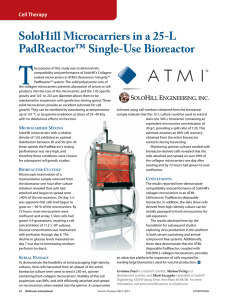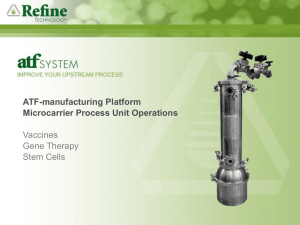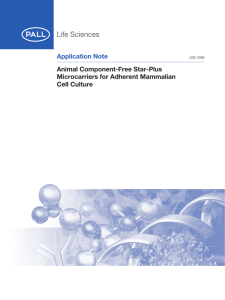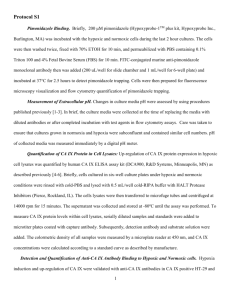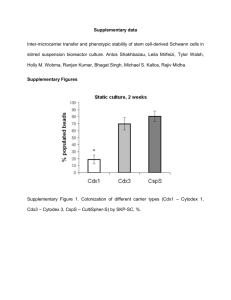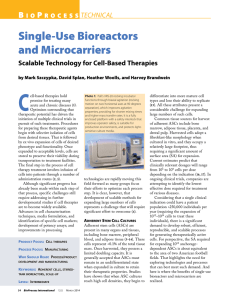Application Note SoloHill Microcarriers Support Normal
advertisement
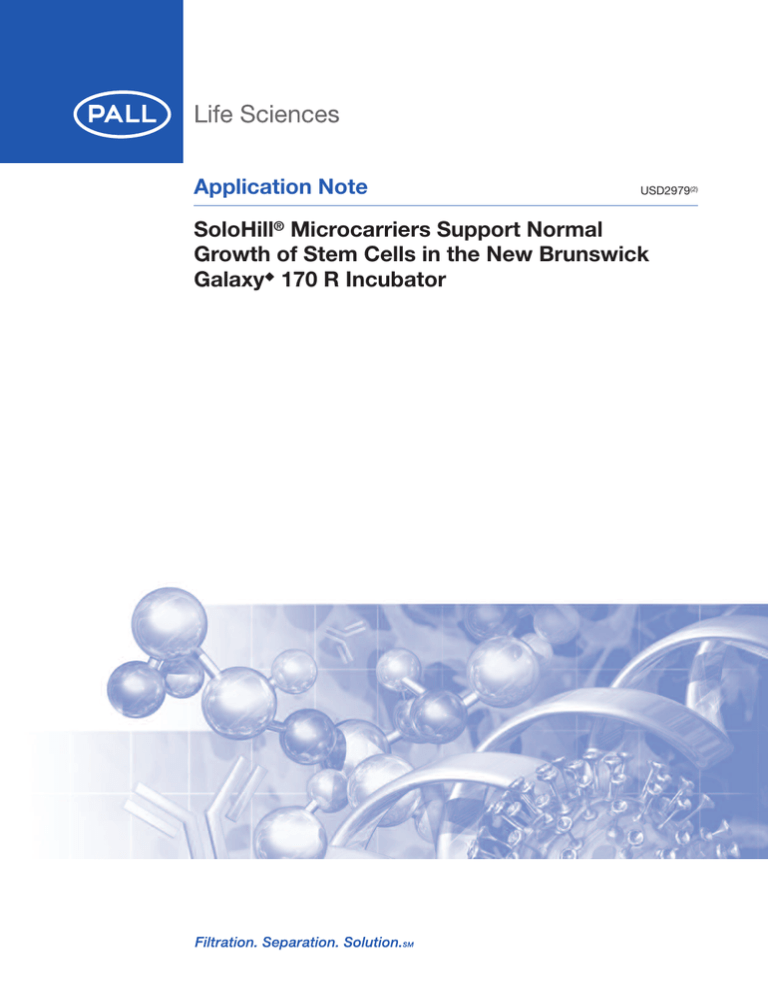
Application Note USD2979(2) SoloHill® Microcarriers Support Normal Growth of Stem Cells in the New Brunswick Galaxy◆ 170 R Incubator Abstract HumanMesenchymalStemCells(hMSCs)areknowntoberesistanttothetoxicityofoxygendeprivation, or hypoxia,andmayevengrowtohigherdensitiesundertheseconditions.TheNewBrunswickGalaxy170series incubatorshaveawidearrayofoptionsthatallowfornotonlyCO2 andtemperaturecontrol,butalsoforoxygen concentrationcontrol,whichcanbeusedtocreateahypoxicinternalenvironment. TodemonstratethelowoxygencapabilityoftheGalaxy170system,hMSCswereculturedin3%oxygen.Their growthandmorphologywerecharacterizedoverasevendaygrowthperiodonPall microcarriersinstirred vessels.hMSCswereshowntogrownormallyand,insomecases,achievedhighercelldensitiesunderhypoxic conditions,comparedtonormaloxygen(~18-21%),ornormoxicconditions.Followingthisgrowthperiod,the retentionofstemcell-likecharacterwasconfirmedbystainingandvisualizingseveralstemcellmarkerswith complimentaryantibodies.Thedifferentiationpotential,orretentionofmultipotency,ofhMSCswasalsoconfirmed, ascellswereabletodifferentiateintoadipocyctesandosteocytesatlevelscomparabletocellsgrownonflatware underthesameconditions. Introduction hMSCsareself-renewingcellsthatcandifferentiateintoseveralterminallydifferentiatedcelltypes.Thesecells canbeisolatedfrommultiplesourcessuchasbonemarrow,adiposetissue,peripheralblood,andotheradult tissues1-6.Theinterestinthesecellsliesintheirpotentialtorepairdamagedtissueandcuredisease.Several indicationsarecurrentlybeingaggressivelypursuedinclinicaltrials.Threeemergingfieldsofinterestforstem cellsarecellulartherapy,regenerativemedicine,andtoxicologyscreeningfordrugdevelopment. Fortoxicologyscreeningandsomecelltherapyapplications,largenumbersofcellsareneeded.Expansionof adultstemcellsisdifficultsincetheyhaveafinitelifespanandpluripotencycanbelost.Two-dimensional(2D) culturesystemssuchast-flasks,cellcubes/factories,androllerbottlesarecommonproductionplatformsfor vaccineandbiologicsmanufacturingaswellascelltherapy.Althoughwell-established,theseformatsoccupya largefootprint,arelaborintensiveandaresusceptibletocontaminationproblemsduetonumerousopenhandling steps.Microcarriersofferalargesurfaceareaforgrowthofanchorage-dependentcelltypes,andcouldthereby facilitateuseofbioreactorsforstemcellexpansion. RecentresearchhasshownthathMSCgrowthcanbesignificantlyaffectedbyoxygenconcentration.Themost commonapproachistoculturehMSCsinanenvironmentthatcloselymimicsphysiologicalconditions,which havebeenshowntoberoughlybetween1%and6%oxygenforbonetissue7-8.Researchhasdemonstrated thathMSCculturedatlowoxygen,orhypoxic,conditions,growandproliferatetomuchhighercelldensities9-11. However,thereisconflictingresearchthatsuggestshypoxicconditionscannegativelyimpactcelldifferentiation orreducecellgrowth(12-15).Inthispublication,wedemonstratethatlow-O2 cellcultureconditionsareeasily establishedusingtheNewBrunswickGalaxy170Rincubatorwith1-19%O2 control,allowingforevaluationof hMSCgrowthonmicrocarriersinstirredculturesathypoxicandnormoxicconditions. Materials and Methods Stirred Vessel and Microcarriers Allcellsusedforthisstudywereisolatedfromasingledonorofhumanbonemarrow-derivedMSCs(Passage1) thatwerepurchasedfromEMDMillipore(SCR108).CellswereculturedinCorning◆ 125mLspinnervessels (FisherScientific10-203B)onSoloHillmicrocarriers.CellswereculturedinCorning125mLspinnervessels (FisherScientific10-203B)onseveraltypesofSoloHillmicrocarriers(Table1).Themicrocarrierswereevaluated atbothhypoxicandnormoxicconditions. 2 Table 1 Description of SoloHill Microcarriers Evaluated Microcarrier Name Product Number Protein Coating Surface Charge Collagen-Coated Plastic Pronectin® F-Coated Plastic Plus C102-1521 P102-1521 PF102-1521 PP102-1521 Porcine Gelatin None RGD-containing peptide None None None None Cationic Incubator CellculturewascarriedoutinoneGalaxy170Rincubatorwithhightemperaturedisinfection,4-doorsplitinner door,and1-19%oxygencontrol(Eppendorf).First,theGalaxy170Rwasusedforcultureinhypoxicconditions, thennormoxicoxygenconditions.SetpointsonbothunitsfortemperatureandCO2 concentrationwere37˚C and5%,respectively.Forhypoxicconditions,theGalaxy170Rwassetat3%oxygenandallowedtostabilizeat setpointfor72hoursbeforecellswereintroducedintotheincubator.Atnormoxicconditions,oxygencontrolwas disabledandtheincidentaloxygenconcentrationwas18-19%.Overthecourseoftheculture,neitherCO2 nor oxygenconcentrationsdeviatedfromthesetpointbymorethan0.2%,exceptininstancesaftertheincubator doorwasopened.Followingtheseinstances,gasconcentrationsreturnedtothepropersetpointusuallywithin 10minutes.Alltransientcultureparameters,includingoxygenconcentration,couldbemonitoredandrecorded usingtheconvenientinterfaceprovidedwiththeunitaswellaswithsupplemental BioCommand◆ software(New Brunswick◆ Scientific). Culture Medium MSCswereexpandedinlow-glucoseGibco◆ DMEM(LifeTechnologies11054)supplementedwith10%fetal bovineserum(FBS)(ThermoScientificSH30071.03),2mML-glutamine(ThermoScientificSH30034.02), 50µg/mLpenicillin/strepto-mycin(AmericanTypeCultureCollection30-2300),and8ng/mlbasicFibroblast GrowthFactor(bFGF)(EMDMilliporeGF003).“Complete”mediumreferstothisformulation. Cell Expansion on Flatware Toprepareenoughcellsforuseinthisstudy,cellswereinitiallyexpandedfortwopassagesonCorning◆ Rectangular CantedNeckCellCultureT-Flasks(430825,430639,and430641).Flaskswereseededat3,000cells/cm2 and culturedfor7days,oruntiltheflaskswere~100%confluent.50%mediumexchangeswereperformedondays 3and5.Tosubculturecells,mediumwasdecantedandcellswererinsedoncewithPBS(ThermoScientific SH30028.03).ThePBSwasimmediatelydecantedandreplacedwith1-3mLofTrypLE(LifeTechnologies 12563-029)+0.3%PluronicF68(LifeTechnologies24040-32)aspluronicacidhasbeenshowntohavemembranestabilizingproperties,protectingcellviabilityduringthisstepwasadded.Flaskswereincubatedat37°C untilcellsdetached-approximately5-10minutes.Thecellswereresuspendedwithcompletemediumandthen centrifugedat300gfor5minutestopelletthecells.MediumandTrypLEwereremoved.Cellswereresuspended in10mLcompletemediumbutwithoutbFGFandcountedusingtrypanbluestain(MPBiomedicals1691049) andahemacytometer.Aftercentrifugation,cellswereresuspendedinfreezingmedium(completemedium+10% DMSO)at~2.5millioncells/mL,aliquotedinto1.5mLvials,andfrozentocreateaworkingcellbankforthis experiment. Afterthawingcellsfromthecellbank,andpriortoseedingcellsontothemicrocarriers,cellsweregrownfor anadditionalpassageinT-flasks,asthiswasfoundtoimprovecellhealthandviability.Thawedcellswere resuspendedin10mLbasalmediumandpelletedviacentrifugation.Themediumwasdecanted,andcellswere resuspendedin10mLcompletemedium.CellswerethencountedandusedtoseedT-Flasksat5,000cells/cm2. Cellsweregrownfor7days,with50%mediumexchangesondays3and5. www.pall.com/biopharm 3 Cell Seeding and Expansion in Spinners Spinnerswereoperatedatamicrocarrierconcentrationof5cm2/mLandavolumeof75mL.Cellssubcultured onflatwarewereusedtoseedthespinnersatadensityof5,000cells/cm2.Spinnercultures wereperformedas describedinpreviousmicrocarrierprotocols16.Briefly,forCollagen,Plastic,PronectinF,andPlasticPlus microcarriers,cellswereseededinmedium(acclimatedtocultureconditionsfor20minutespriortoseeding) andsupplementedwith0.05%FBSintheabsenceofbFGFfor3-4hoursoruntilapproximately>80%ofthe cellsattached.SerumandbFGFwerethenaddedtotheculturetosupplementthebasalmediumtothetarget of10%FBSand8ng/mLbFGF.Microcarriercultureswereagitatedat40RPM.50%mediumexchangeswere performedondays3and5.Glucosesupplementationto100mg/dLwasperformedondays4and6.Cell countstoquantifygrowthwereperformedondays3,5,6,and7. Cell Harvesting from Spinners Onday7,thespinnerswereharvestedtodeterminefinalcellrecoveries.Thefirstagitationwasstopped,microcarriersallowedtosettle,andthemediumwasthenremoved.Cellsandmicrocarrierswerewashedwith40mL DPBSfor5-10minutesatroomtemperaturewithgentleagitationtoresuspendmicrocarriers.Themicrocarriers werethenallowedtosettleandtheDPBSwasremoved.TrypLE(7.5mL)containing0.3%pluronicacidwas added.Thespinnersweregentlypipettedonceortwicetothoroughlymixandthenincubatedat37°Cfor 10minutes(withoccasionalgentlerockingbyhand).Cellsandmicrocarrierswerethenpipettedtomechanically dissociatethecellclumpsintoasingle-cellsuspension,thenpassedthrougha100µmmeshcellstrainer(Fisher Scientific22-363-549)toremovemicrocarriers.Spinnerswerethenwashedwith10mLofcompletemedium, whichwasthensubsequentlypassedthroughthestrainerandintothecellpooltoimprovecellrecoveriesand inactivatetheTrypLE.Thecellpoolwascentrifuged,decanted,andresuspendedin10mLofmediumcontaining 0.05%FBSforcellcounting. Cell Counts Cellcountswereperformedroutinelyduringtheculturetomonitortheprogressofcellgrowth.A2mLsample wasobtainedfromeachspinner;microcarrierswereallowedtosettle,then1.75mLofmediumwasremoved andreplacedwith1.75mLofDPBS.Again,microcarrierswereallowedtosettlebeforeremoving1.75mL ofPBSandadding0.75mLofTrypLEcontaining0.3%pluronicacid.Cellswereincubatedat37°Cfor5to 10minutes.Afterincubation,1.0mLofcompletemediumwasadded.Themixturewaspipette10timesto mechanicallydissociatecellclumps.Theresultingcellslurrywasthencountedviahemacytometer.Following thecount,sampledmicrocarriersweredriedandweighedsothatcellcountcouldbeadjustedtoaccountfor thesampledmicrocarriersurfacearea. Stem Cell Marker Visualization TovisualizetheexpressionofseveralstemcellmarkersonMSCs,samplesweretransferredfromthespinners into15mLtubes.Oncethemicrocarrierssettled,mediumwasremovedandcells/microcarrierswerecarefully washedwithDPBSfor5minutesatroomtemperature.Oncethecellsandmicrocarrierssettled,theDPBSwas removedandcellsandmicrocarrierswerefixedin4%paraformaldehydefor10minutesatroomtemperature. Thepara-formaldehydewasthenremoved,andcellswerewashedinDPBSforstorageat4°Cuntiluse.To visualizestemcellmarkers,500µLofeachsampleweretransferredto1.5mLtubes,microcarrierswereallowed tosettleandDPBSwasremoved.Non-specificbindingwasblockedbyincubationwith5%FBSinDPBSfor onehouratroomtemperature.Sampleswerewashedin500µLDPBS3five-minutecyclesatroomtemperature. Sampleswerethenincubatedin500µLofthedye/antibodysolutions.Dyesandantibodiesusedwere:DAPI(Life Technologies,D3571),phalloidin-FITC(LifeTechnologies,A12379),FITCanti-humanCD44(BioLegend338803), APCanti-humanCD90(BioLegend328113),andAlexaFluor647anti-humanStro-1(BioLegend340103). ilutionsusedforallantibodieswere1:100,withtheexceptionofStro-1,whichwasusedat1:500. 4 Attachment Assessment Toassessthedistributionofcellattachmentacrossthemicrocarrierpopulation,a2mLsamplewastakenfrom eachspinnerapproximately5to6hoursafterseeding.Samplesweretransferredfromthespinnersintoa15mL Falcontubeandtreatedasdescribedin“StemCellMarkerVisualization.”Tovisualizecellattachment,500μLof samplewastransferredtoasinglewellofa24-wellplateandincubatedwith0.5µLofDAPIstain.Cellswere visualizedunderfluorescentlight,andthenumberofcellspermicrocarrierweretabulatedforapopulationof >50microcarriers. Adipogensis and Osteogensis Differentiation TodeterminedifferentiationpotentialoftheMSCsexpandedonSoloHillmicrocarriers,cellsharvestedfrom spinnerswerefrozen,thenthawed,andseededon24-wellplatesat6,000cells/cm2.Growth/expansionmedium wasremoved,and1mLofeitherOsteogenesisInductionMedium(EMDMilliporeSCR028)orAdipogenesis InductionMedium(EMDMilliporeSCR020)wasadded.Inductionandmaintenancemediawerechanged accordingtoEMDMillipore’sprotocol(asrecommendedbysupplier).Osteocytedifferentiationwasdetermined byAlizarinRedSstainingandadipocytedifferentiationwasdeterminedbyOilRedOstaining(protocolssupplied withEMDMilliporekits). Results and Discussion Attachment MSCsweregrownonSoloHillmicrocarriersfor7daysatnormaloxygenlevels.Theattachmentdistributionwas assessed5to6hoursafterseeding(Figure1).Atthecurrentcellseedingdensity(5,000cells/cm2),eachmicrocarrieronaverageshouldcontainabout~4cellsperbead.Anevendistributionofcellsacrossthemicrocarrier populationleadstothemosteffectiveutilizationoftheavailablesurfaceareaandusuallycorrelatestothehighest celldensitiesifthesurfaceisfavorableforgrowth.Microcarrierswithnocellsboundcanbeanearlyindicationof aninefficientculturethatmaynotreachitsmaximumcelldensity. Resultsdifferedslightlydependingontheoxygencondition.Underhypoxicconditions,lessthan15%ofthe microcarrierpopulationwaswithoutcellsafter5to6hoursofculture.Atnormoxicconditions,thisnumber wasslightlyhigherat~20%forsomemicrocarriertypes;however,therewasmuchhighervariabilityamong thereplicatesforthiscondition.Thehighvariabilitywasduetooneblockofreplicatesinwhichallspinners wereseededfromthesamecellfeedmaterial.Forthisexperimentalblock,attachmentwascomparatively poorerforallconditionsandmayhavebeenrelatedtothecellhealth,ratherthantheoxygencondition.Although mostmicrocarriershad,onaverage,lessthan4cellsperbead,thisnumberincreasedastheremainingunbound cellscontinuedtoattachoveralongertimeinterval,sothebiologicalrelevanceoftheseattachmentdifferences maynotbesignificant. Attachmentdidnotseemtobeaffectedbythemicrocarriertypeevaluated.AlthoughPlasticPlussamples containedthelowestpercentageofmicrocarrierswithoutcells,whileCollagencontainedthehighest,therelatively highvariabilitybetweenthereplicatesmadeitdifficulttodrawaconclusionwithanystatisticalsignificance. www.pall.com/biopharm 5 60% Normoxic Collagen Plastic Pronectin F Plastic Plus 50% 40% 30% 20% 10% 0% 0 1 3 2 Cells per Microcarrier 4 >5 Percent of Microcarrier Population Percent of Microcarrier Population Figure 1 Attachment distribution of MSCs at normoxic and hypoxic oxygen concentrations on SoloHill microcarriers after 5 to 6 hours. Data were obtained via DAPI staining. Data points represent the average of n=3 replicates. Error bars indicate +/- one standard deviation. Data were broken down into 2 graphs (a, left) normoxic and (b, right) hypoxic, for easier visualization 60% Hypoxic Collagen Plastic Pronectin F Plastic Plus 50% 40% 30% 20% 10% 0% 0 1 2 3 Cells per Microcarrier 4 >5 Cell Growth Celldensitiesofcultureswerequantifiedusingcellcountstogenerategrowthcurves(Figure2).Results obtainedweregenerallyconsistentwithpastfindings,inwhichcelldensitiesreached6-10x104 cells/cm2, withsomeexceptions.Mostnotably,cellsgrewtomuchhigherdensitiesonflatwareinthisexperiment,as previousflatwaredensitiesonlyreachedapproximately4x104 cells/cm2.Thisdifferencemaybeduetothe 40%higherseedingdensityusedtoseedflatwareinthisstudy.Inaddition,growthoncollagenmicrocarriers undernormoxicconditionswashigherthanthehistoricalrange,whilegrowthonPlasticPlusmicrocarriers undernormoxicconditionswaslowerthanthehistoricalrange.However,giventhelargevarianceamongthe differentspinnerreplicatesinthisstudy(indicatedbytheerrorbarsinFigure2)andthevariationinseeding densitytestedhistorically,thesedifferencesmaynotbesignificant.Allotherconditionstestedwerecomparable tothehistoricalrange. Thedependencyofcelldensityonoxygenconditionasindicatedbydailycellcountswasvariableand dependedonthemicrocarriertypetested.Thenatureofthegrowthcurveforthenormoxicconditiondiffered fromthehypoxicconditionsinthatnormoxicgrowthlaggedbehindhypoxicgrowthearlierintheculture,butthen acceleratedlaterintheculture.InthecaseofCollagenmicrocarriers,celldensitiesweresimilarthroughday6, butgrowthappearedtoaccelerateundernormoxicconditionsandtheresultingcelldensitywashigheronday7. Thesametrendwasobservedontheflatwarecontrols.ForPronectinFmicrocarriers,celldensitiesunderhypoxic conditionswerehigherthroughday6,butnormoxicgrowthappearedtoaccelerate,andcelldensitieswere equivalentonday7.Thesetrendsaredifficulttoconcludewithcertainty,astherewasalargeamountofvariation betweenthereplicates,eitherduetosamplingorbiologicalvariability.AsimilartrendwasobservedonPlastic Plusmicrocarriers,butcelldensitiesremainedloweratnormoxicconditionsthroughoutthedurationofthe culture.OnPlasticmicrocarriers,therewerenoobserveddifferencesincelldensities. Celldensitieswerealsodependantonthetypeofmicrocarriertested:Whilethevariabilitybetweenthereplicates madeitdifficulttomakestatisticaldistinctionbetweengrowthonCollagen,Plastic,andPronectinFmicrocarriers, cellsdiddisplaymorefavorablegrowthonthesemicrocarriersincomparisontoPlasticPlus. 6 Figure 2 Cell densities for MSC cultures at normoxic and hypoxic oxygen concentrations on SoloHill microcarriers. Cell densities were obtained via cell counts. Data points represent the average of n=3 replicates. Error bars indicate +/- one standard deviation. For easier visualization, data were broken down into 4 graphs: (a, top left) Collagen, (b, top right) Plastic, (c, bottom left) Pronectin F, and (d, bottom right) Plastic Plus and flatware controls. 18.0 Collagen (hypoxic) 16.0 Collagen (normoxic) 14.0 Cell Density (E4 Cells/cm2) Cell Density (E4 Cells/cm2) 18.0 12.0 10.0 8.0 6.0 4.0 2.0 Plastic (normoxic) 14.0 12.0 10.0 8.0 6.0 4.0 2.0 0.0 0 1 2 3 4 Day 5 6 7 0.0 8 0 1 18.0 18.0 Pronectin F (hypoxic) 16.0 Pronectin F (normoxic) Cell Density (E4 Cells/cm2) Cell Density (E4 Cells/cm2) Pastic (hypoxic) 16.0 14.0 12.0 10.0 8.0 6.0 4.0 2 3 4 Day 5 6 7 8 5 6 7 8 Plastic Plus (hypoxic) Plastic Plus (normoxic) ypoxic) Flatware Control (Hypoxic) Flatware Control (Normoxic) 16.0 14.0 12.0 10.0 8.0 6.0 4.0 2.0 2.0 0.0 0.0 0 1 2 3 4 Day 5 6 7 8 0 1 2 3 4 Day Cell Harvest Asobservedpreviously,MSCstendtoformbridgesbetweenmicrocarrierslateintheculture.Thisnetwork ofbridgesleadstomicrocarrieraggregatesthatvaryinsize,whichcancontributetovariabilityindailysampling. Theexactmechanismformicrocarrieraggregateformationaswellashowtheaveragedensityofcellsinthese clumpscomparestothedensityofcellsonsinglesuspensionmicrocarriers,isanareaofongoinginvestigation. Therefore,spinnerswereharvestedonday7,andtheresultingcellpoolwascountedtogenerateaharvestcell density(Figure3)asapotentialmeanstogainamoreaccurateunderstandingofthetruecelldensityoverthe entiremicrocarrierpopulation.Thisapproachalsoprovidesinsightastohowmanycellscanbeharvestedand furtherexpanded. Resultsfromthisharvestmethodsuggestthathypoxicconditionswereslightlymorefavorableingenerating highcelldensitiesonmicrocarriersincomparisontonormoxicconditions.Thisresultissupportedbythedata suggestingattachmentunderhypoxicconditionswasonaveragebetterthannormoxicconditions,asbetter attachmentkineticsoftenlaythefoundationforhighercelldensitieslaterintheculture.Dailycelldensity measurementswerealsogenerallysimilarorhigherunderhypoxicconditionsthroughday6oftheculture, suggestingthattheapparentacceleratednormoxicgrowthonday7mightbeasamplingorassayartifact. Alternately,theharvestmethodusedforthesespinnerscouldbepreferentiallyfavorabletocellsgrownunder hypoxicconditions,ashypoxicconditionsmaybeimprovingcellrobustnessandmakingcellsmoreresistant tothestressesofharvesting.Regardlessofinterpretation,thesedatasuggestthatthereissomeadvantage togrowinghMSCsonmicrocarriersathypoxicconditions. www.pall.com/biopharm 7 Inthecaseofflatwarecontrols,thedatadonotsupporttheconclusionthathypoxicconditionsarebeneficial. However,theprocedureusedtoharvestflatwarewasslightlydifferentthantheproceduretoharvestmicrocarriers, namelycellsdonotexperiencethesamemagnitudeofshearforces.Althoughcelldensitiesappearhigherfor normoxicconditions,thisdifferenceisnotstatisticallysignificantandthereforemaynotrepresentatruedeparture fromtheoveralltrend. Figure 3 Harvested day 7 cell densities for MSC cultures at hypoxic oxygen concentrations compared to normoxic oxygen concentrations on commercial SoloHill microcarriers and flatware controls. Cell densities were obtained via cell counts. Data points represent the average of n=3 replicates. Error bars indicate +/- one standard deviation. Cell Density (E4 cells/cm2) 14.0 Hypoxic 12.0 Normoxic 10.0 8.0 6.0 4.0 2.0 0.0 Collagen Plastic Pronectin F Plastic Plus Flatware Surface Cell Morphology, Identity, and Differentiation Potential Ondays3,5,and7oftheculture,sampleswereobtainedandstainedwithDAPItohelpvisualizethethreedimensionalconfluencyandmorphologyofcellsonmicrocarriers.Acomparisonofcellsculturedinhypoxicvs. normoxicconditionsoncollagenmicrocarriers(Figure4)revealednodifferencesinconfluencylevelsduring culture.Allcellswereofpropermorphology,indicatinggoodhealthandviabilityoftheculture. Figure 4 3D-stacked Fluorescent DAPI stained images (4x magnification) of hMSCs on Collagen microcarriers at 3, 5, and 7 days. The similarities in cell morphology between hypoxic and normoxic conditions are representative of other microcarrier types. Collagen Normoxic Collagen Hypoxic Day 3 8 Day 5 Day 7 Day7sampleswereobtainedpriortoharvestandstainedtoverifytheretentionofstemcellmarkersasan indicationofstemcell-likeidentity.Additionally,cellswereseriallypassagedonplasticmicrocarriersathypoxic conditionsforatotalof6passages,andsamplesfrompassage6werecomparedtocellsobtainedfrompassage1 (Figure5).BothsamplesstainedpositiveforCD44,CD90(notshown),andStro1,indicatingretentionofstemcell identity.Resultsarerepresentativeforallmicrocarriertypesafterpassage1atbothhypoxicandnormoxic conditions(datanotshown),butserialpassagingwasperformedonlyonplastic. Figure 5 MSCs expanded on SoloHill microcarriers were incubated with anti-CD44 (green), anti-Stro1 (red) and DAPI (blue) at 10X magnification. Exposure times were adjusted for maximum contrast. High background resulted from lengthy exposure times due to low expression levels. Populations of CD44 expressing cells are indicated by green arrows. Populations of Stro1 expressing cells are indicated by red arrows. Populations of cells expressing both markers are indicated by yellow arrows. Results are representative of all microcarrier types tested. Plastic, Hypoxic, Passage 6 Plastic, Normoxic, Passage 1 DAPI+CD44 +Stro1 CD44+Stro1 DAPI+Stro1 DAPI+CD44 Plastic, Hypoxic, Passage 1 www.pall.com/biopharm 9 Finally,cellsseriallypassaged6timesonanimal-derivedcomponentfreeplasticmicrocarriersathypoxic conditionsweresuccessfullydifferentiatedintoadipocyctesandosteocytesfollowingboththefirstandsixth passage(Figure6).Adipogensiswasindicatedbythepresenceofred-stainedlipiddropletsandosteogenesis wasindicatedbyacalcificationlayerandthepresenceofred-stainedcalciumphosphatedeposits. Figure 6 Cells serially passaged six times on animal derived component free plastic microcarriers differentiate into adipocyctes and osteocytes. Bright field images were taken with a Nikon Ti65 at 20X (adipocyctes) and 10X (osteocytes). Arrows indicate lipid droplets and calcium phosphate deposits. First passage undifferentiated sample were stained with Alizarin Red, Sixth passage undifferentiated samples were stained with hematoxcylin solution. First Passage Adipogenesis Osteogenesis Plastic Microcarriers Flatware (Control) Control (Undifferentiated) Sixth Passage Adipogenesis Osteogenesis Plastic Microcarriers Flatware (Control) Control (Undifferentiated) Conclusions hMSCsgrownonSoloHillmicrocarriersunderhypoxicconditionsdisplaynormalgrowthascomparedtothose grownatnormoxicoxygenconcentrations.Datapresentedheresuggestthatmorecellscanbeharvested frommicrocarriersgrownunderhypoxicconditions.Thesecellsalsoretainedstemcellidentityandpluripotency. TheeaseofsetupandthetightoxygenconcentrationcontroldisplayedbytheGalaxy170Rincubatorprovided theidealconditionsforthisexperiment.Thisstudyisademonstrationofthelowoxygenfeaturethatisavailable ontheGalaxy170seriesincubatorsaswellassuccessfulgrowthofhMSCsonPallSoloHillmicrocarriers,and thepotentialbenefitsofhypoxicstemcellgrowth. 10 References 1.FriedensteinAJ,GorskajaJF,KulaginaNN.Fibroblastprecursorsinnormalandirradiatedmousehematopoieticorgans.Exp Hematol 1976,4:267-274. 2.Fraseretal.Fattissue:anunderappreciatedsourceofstemcellsforbiotechnology.Trends Biotechnol 2006, 24:150-154. 3.CaoC,DongY.Studyoncultureandinvitroosteogenesisofblood-derivedhumanmesenchymalstemcells. Zhongguo Xiu FuChongJian Wai Ke Za Zhi.2005.19:642-647. 4.GriffithsMu,BonnetD,JanesSM.StemCellsoftheAveolarepithelium.Lancet.2005,366:249-260. 5.Beltramiet al. Adultcardiacstemcellsaremultipotentandsupportmyocardialregeneration.Cell. 2003,114: 763-776. 6.Pittengeret al. Multilineagepotential 7.Chow,D.C.,Wenning,L.A.,Miller,W.M.&Papoutsakis,E.T.2001a.ModelingpO2distributionsinthebone marrowhematopoieticcomparment.II.modifiedKroghianmodels.Biophysical Journal,81,685-696. 8.Chow,D.C.,Wenning,L.A.,Miller,W.M.&Papoutsakis,E.T.2001b.ModelingpO2distributionsinthebone marrowhematopoietic 9.Estrada,J.C.,Albo,C.,Benguría,A.,Dopazo,A.,López-Romero,A.,Carrera-Quintanar,L.,Roche,E., Clemente,E.P.,Enríquez,J.A.,Bernad,A.&Samper,E.2011.Cultureofhumanmesenchymalstem cellsatlowoxygentensionimprovesgrowthandgeneticstabilitybyactivatingglycolysis.Cell Death and Differentiation,19,743-755. 10.Grayson,W.L.,Zhao,F.,Bunnell,B.&Ma,T.2007.Hypoxiaenhancesproliferationandtissueformationof humanmesenchymalstemcells.Biochemical and Biophysical Research Communications,358,948-53. 11.Hung,S.P.,Ho,J.H.,Shih,Y.V.,Lo,T.&Lee,O.K.2012.Hypoxiapromotesproliferationandosteogenic differentiationpotentialsofhumanmesenchymalstemcells.Journal of Orthopaedic Research,30,260-266. 12.Fehrer,C.,Brunauer,R.,Laschober,G.,Unterluggauer,H.,Reitinger,S.,Kloss,F.,Gully,C.,Gassner,R.& Lepperdinger,G.2007.Reducedoxygentensionattenuatesdifferentiationcapacityofhumanmesenchymal stemcellsandprolongstheirlifespan.Aging Cell,6,745-57. 13.Holzwarth,C.,Vaegler,M.,Gieseke,F.,Pfister,S.M.,Handgretinger,R.,Kerst,G.&Muller,I.2010.Low physiologicoxygentensionsreduceproliferationanddifferentiationofhumanmultipotentmesenchymal stromalcells.BMC Cell Biology,11,11. 14. Wang,D.W.,Fermor,B.,Gimble,J.M.,Awad,H.A.&Guilak,F.2005.Influenceofoxygenontheproliferation andmetabolismofadiposederivedadultstemcells.Journal of Cellular Physiology,204,184-191. 15.Zeng,H.-L.,Zhong,Q.,Qin,Y.-L.,Bu,Q.-Q.,Han,X.-A.,Jia,H.-T.&Liu,H.-W.2011.Hypoxia-mimetic agentsinhibitproliferationandalterthemorphologyofhumanumbilicalcord-derivedmesenchymalstem cells.BMC Cell Biology,12,32. www.pall.com/biopharm 11 Visit us on the Web at www.pall.com/biopharm E-mail us at microcarriers@pall.com Customer Ordering PallLifeSciences 4370VarsityDrive,SuiteB AnnArbor,MI48108 microcarriers@pall.com 734-973-2956phone Corporate Headquarters Port Washington, NY, USA +1.800.717.7255tollfree(USA) +1.516.484.5400phone biopharm@pall.come-mail European Headquarters Fribourg, Switzerland +41(0)263505300phone LifeSciences.EU@pall.come-mail Asia-Pacific Headquarters Singapore +6563896500phone sgcustomerservice@pall.come-mail International Offices PallCorporationhasofficesandplantsthroughouttheworldinlocationssuchas:Argentina, Australia,Austria,Belgium,Brazil,Canada,China,France,Germany,India,Indonesia,Ireland, Italy,Japan,Korea,Malaysia,Mexico,theNetherlands,NewZealand,Norway,Poland,Puerto Rico,Russia,ingapore,SouthAfrica,Spain,Sweden,Switzerland,Taiwan,Thailand,theUnited Kingdom,theUnitedStates,andVenezuela.Distributorsinallmajorindustrialareasofthe world.TolocatethePallofficeordistributornearestyou,visitwww.pall.com/contact Theinformationprovidedinthisliteraturewasreviewedforaccuracyatthetimeofpublication. Productdatamaybesubjecttochangewithoutnotice.Forcurrentinformationconsultyour localPalldistributororcontactPalldirectly. © 2015, Pall Corporation. Pall, , and SoloHill, are trademarks of Pall Corporation. ® indicates a trademark registered in the USA and TM indicates a common law trademark. is a service mark of Pall Corporation. ◆Galaxy, New Brunswick and BioCommand are trademarks of Eppendorf; EMD Millipore is a trademark of Merck KGaA; Corning and Falson are trademarks of Corning Corporation; GIBCO and TrypLE are trademarks of Life Technologies Corporation; Pluronic is a trademark of BASF Corporation; ProNectin is a trademark of Sanyo Chemical Industries, Ltd.; Pluronic is a trademark of BASF and Alexa Fluor is a trademark of Molecular Probes, Inc. 2/15,PDF,GN15.6117 USD2979(2)
